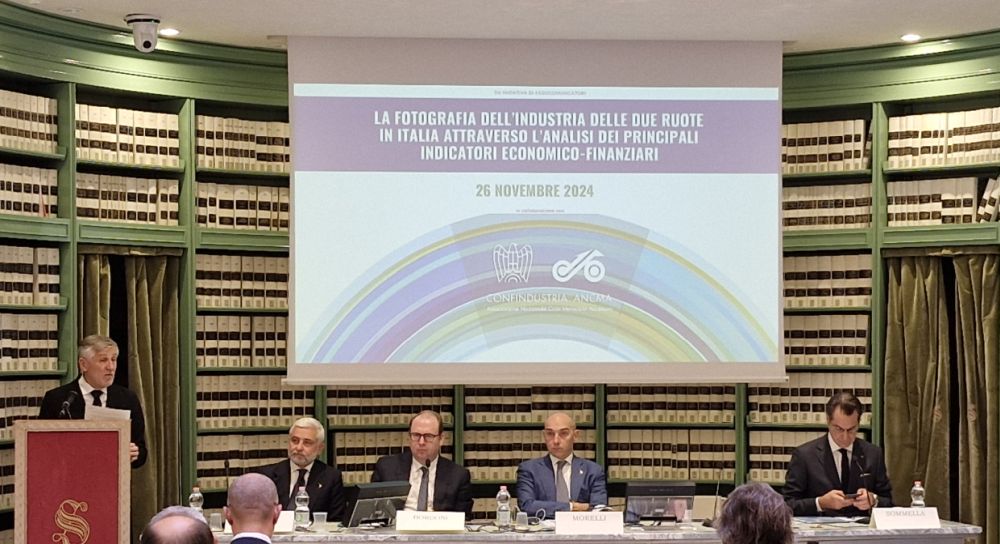ROME (ITALPRESS) – The motorcycle and bike industry in Italy is worth a total of 14.8 billion. The number of A licenses is growing (one in five of those issued, for a total of 280,000, +6% from 2013 to 2023 compared to +1% for B licenses) and the motorcycle market is the driving market (+42% from 2020 to 2023), while the two-wheeled pedal-assisted one – net of the success of e-bikes – is now experiencing a moment of slowdown in demand, after the booms recorded in 2020 and 2021. This is the picture that emerges from the study presented by Confindustria Ancma in the Senate and conducted by Bain & Company Italia. For the association’s president, Mariano Roman, the two-wheeler sector “creates significant induced revenues with sporting events and the international exhibition excellence of Eicma, which provides employment, sustainable mobility, which contributes close to 180 million to tax revenues. Today we produce 17 percent of the bikes built and assembled in Europe (2 million), while the motorcycle sector exports 2 billion motorcycles, scooters and mopeds and produces 422 thousand units in Italy, firmly occupying first place in the eurozone, where it compares with Germany’s 161 thousand, Austria’s 124 thousand and France’s 89 thousand.”To continue to compete internationally, the sector “needs support that matches its value, more incisive subsidiary policies that generally encourage aggregation, investment in research and development and the establishment of component supply chain production sites on the high end,” while for bicycles, “more specific actions are needed that concern support for the use and, above all, bicycle infrastructure, which is essential to develop our country’s great potential in cycling tourism.” The post-Covid has handed motor two-wheelers a new prominence, not only for urban mobility (scooters), but also in the areas of use traditionally linked to tourism and leisure, namely the motorcycle, which has come to account for as much as 45 percent of registrations in 2023 (it was 34 percent only 10 years earlier) and which, thanks to the success of medium-sized engines, has also gone to meet the demand for commuting and new mobility needs. The positive market trend then translated into a growth in the turnover of the entire motorcycle supply chain, which between 2020 and 2023 marked a +50%, and an increase in average profitability for operators that went from 4.2% to 6% over the same period.A plus sign also for the number of employees, which grew by 7% between 2020 and 2022, settling at just over 36 thousand direct (84 thousand with indirect and induced). Finally, noteworthy is the balance of trade for motorcycles, which closed in 2023 with +470 million, confirming the quality and central role of Italy in exports. On the pedal-powered two-wheeler front, Bain & Company Italia’s study highlights the opposite effects that the Covid pandemic and the bike bonus had on the market, namely +18% in 2020 over 2019 (more than 2 million units sold) and an average annual decline of 17% between 2021 and 2023. Despite the decline in volumes, the bike supply chain still experienced a significant increase in sales, driven in part by rising prices and the success of e-bikes, standing at 2.7 billion euros in 2023, or +50% over 2018. The effects of the pandemic have also impacted the industry’s profitability: due to the crisis in supply chains, margins have in fact returned to 2019 levels, falling from a peak of 7.6 percent in 2021 to 3.2 percent in 2023. Most affected by this scenario were component makers and accessory sellers, who lost nearly ten points of margin. Against a backdrop of major transformations, the most notable element was, as anticipated, the rapid increase in e-bikes, which rose to more than 330 thousand units sold in 2022, with a 20% penetration of the total (it was 3% in 2015 and 11% in 2019), making pedal-powered two-wheelers accessible to a wider audience. However, a progress that revealed the exposure of the Italian supply chain to the supply of electrical components from Asia (which exports 87% of chips), as well as the variable of macroeconomic and geopolitical factors. Between 2020 and 2021, component imports thus marked a solid +79 percent, standing at 664 billion euros until reaching just over 800 in 2022. In any case, the cycle sector, like the motorcycle sector, continues to mark a positive balance in exports, demonstrating the strong demand for products with the Made in Italy brand on international markets: the trade balance in fact indicates +75 million. Finally, positive news comes from the employment trend where, despite the market trend, in two years (2020-2022) the number of employees in the production of bikes and components has grown by 16 percent, from 15,200 to 17,600.(ITALPRESS).-Photo: xi2/Italpress-

